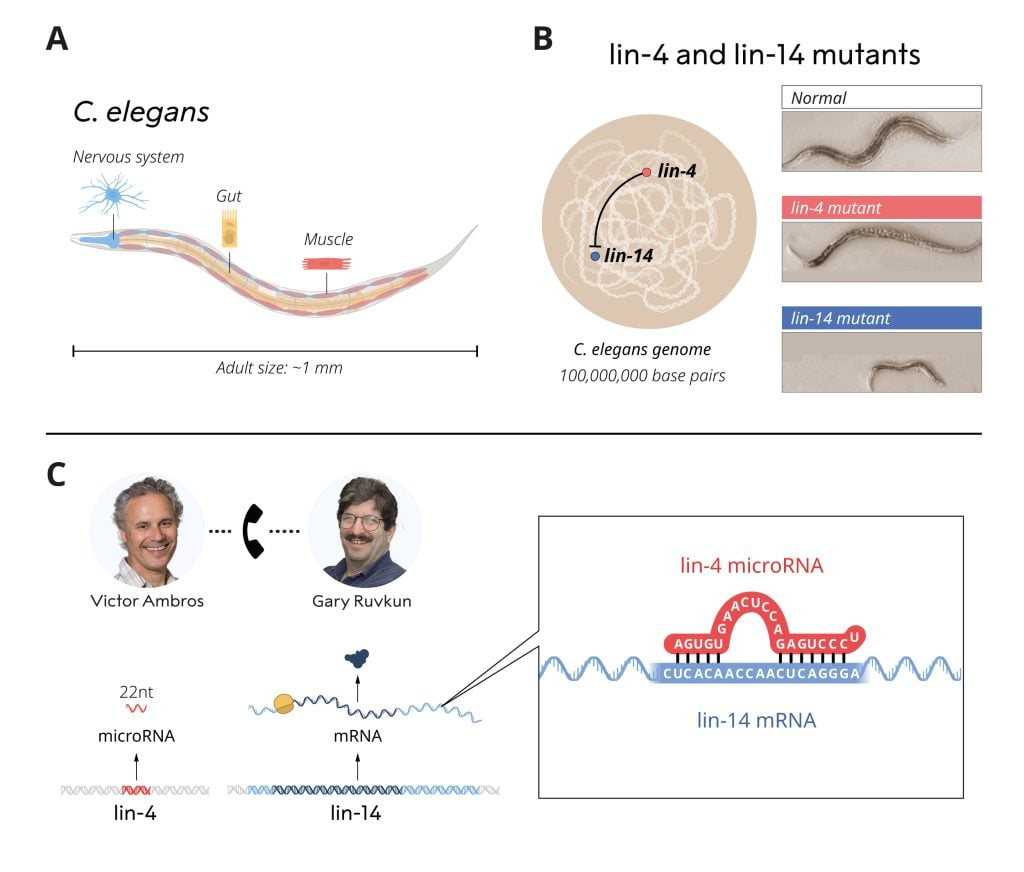
microRNA Discoveries: From Ruvkun to Nobel Prize Glory
MicroRNA discoveries have transformed our understanding of gene regulation, stemming from groundbreaking research by Nobel laureate Gary Ruvkun in the C. elegans roundworm. This pioneering work, which initially attracted modest attention, has since sparked a global interest, culminating in Ruvkun and his colleague Victor Ambros being awarded the 2024 Nobel Prize in Physiology or Medicine. Their findings have revealed the intricate mechanisms by which microRNAs influence gene expression, a breakthrough now supported by substantial NIH funding. This remarkable field not only sheds light on basic biological processes but also paves the way for innovative RNA therapies targeting diseases such as cancer and Alzheimer’s. As scientists uncover the vast potential of microRNAs, their role in human health continues to gain recognition, solidifying their significance in modern genetics.
The realm of small RNA molecules, particularly microRNAs, has become a pivotal topic in genetics and molecular biology. These tiny regulators have been pivotal in elucidating complex gene expression dynamics, following their initial discoveries that linked them to gene control in model organisms like C. elegans. The astounding recognition received by researchers such as Gary Ruvkun underscores the potential applications of this research in therapeutic contexts, including RNA-based treatment strategies for various ailments. Recent funding initiatives and heightened interest among the scientific community have propelled microRNA-related research to new heights, bridging gaps between evolutionary studies and practical medical innovations. As researchers continue to explore these fundamental biological elements, the implications for disease understanding and management are becoming increasingly profound.
The Revolutionary Impact of MicroRNA Discoveries
MicroRNA discoveries have transformed our understanding of gene regulation, particularly through the pioneering work of Gary Ruvkun and Victor Ambros in the early 1990s. Their findings, which identified microRNAs as crucial regulators of gene expression in the C. elegans roundworm, opened up new avenues in molecular biology and genetics. Despite initial skepticism from the evolutionary biology community, the implications of their research have since been acknowledged as groundbreaking, attracting attention from various scientific fields, including those studying human health and disease.
The recognition of microRNA’s role in genetic regulation is underscored by its significance in numerous biological processes. Research has shown that humans possess around 1,000 microRNAs that are integral in controlling protein production. These small RNA molecules are now being explored for their therapeutic potential in treating widespread diseases like cancer and heart disease. As a testament to their revolutionary impact, numerous clinical trials are currently underway to investigate RNA therapies, validating the early insights of Ruvkun and Ambros.
Funding and the Advancement of RNA Research
The long-term support of the National Institutes of Health (NIH) has been pivotal in advancing research related to microRNAs and their applications. Gary Ruvkun’s experience—with approximately 75% of his lab’s funding coming from federal grants—illustrates the importance of continued governmental investment in scientific discoveries. This funding not only sustains laboratories but also fosters innovation and collaboration within the scientific community, highlighting the essential role of federal support in translating basic research into meaningful health solutions.
Ruvkun emphasizes that scientific research is a worthy investment, countering arguments that promote cuts to federal funding. He points out that the scientists in his lab, many of whom hold Ph.D. degrees, contribute significantly to the economy and public health through their research. By providing adequate compensation and resources, federal grants enable researchers to focus on groundbreaking studies that ultimately have the potential to lead to new therapies and improvements in healthcare.
Nobel Prize Recognition and Its Implications
The awarding of the 2024 Nobel Prize to Ruvkun and Ambros highlights the profound impact of their discovery of microRNA on the field of genetics and beyond. This recognition not only solidifies their contributions to science but also underscores the importance of fundamental research in understanding complex biological systems. Nobel laureate status often attracts further attention and funding to research areas that may have previously struggled to gain visibility, effectively transforming the landscape of scientific inquiry.
Moreover, the Nobel Prize serves as a reminder of the serendipity that often accompanies scientific discovery. Ruvkun and Ambros were not initially seen as frontrunners in their field, yet their commitment to exploring the intricacies of gene regulation led to unforeseen breakthroughs. This narrative inspires new generations of scientists, illustrating that persistence in research, often supported by grants and funding, can eventually lead to monumental achievements that reshape our understanding of biology.
The Role of MicroRNAs in Health and Disease
MicroRNAs have been implicated in several critical health conditions, illustrating their importance in medical research. Their ability to regulate gene expression influences processes such as cell differentiation, proliferation, and apoptosis, making them vital components in understanding diseases like cancer, Alzheimer’s, and Crohn’s Disease. Recent studies have pointed to the potential of microRNA-based therapies to modulate these pathways, offering new treatment strategies for complex diseases that currently have limited options.
As this area of research continues to expand, the relationship between microRNAs and various health conditions becomes increasingly clear. With numerous clinical trials evaluating microRNA therapies underway, scientists are hopeful that these small molecules will yield innovative treatments that could dramatically improve patient outcomes. Such advancements underscore the importance of ongoing research in genetics and underscore the need for sustained funding to uncover the therapeutic potential of microRNAs.
The Future of RNA Therapeutics
As research on microRNAs and RNA therapies progresses, the future of these innovations looks promising. Pharmaceutical companies specializing in RNA-based treatments are emerging rapidly, spurred by foundational research funded by federal grants. Companies like Alnylam are paving the way for novel therapeutics that target genetic diseases, demonstrating the commercial potential of discoveries stemming from basic research. This trend highlights the connection between academic discoveries and practical health solutions.
Going forward, the integration of RNA therapies into clinical practice could reshape the way we approach treatment for various conditions. As scientists unveil more about the functionalities and regulatory roles of microRNAs, we may find that these tiny molecules hold the key to unlocking new preventative and therapeutic measures. Continued investment in RNA research will be crucial to accelerating these developments and translating laboratory findings into real-world health benefits.
Insights from Pioneer Gary Ruvkun
Gary Ruvkun’s journey in the field of genetics is a compelling narrative of resilience and curiosity. Having dedicated over four decades to research largely funded by the NIH, he has witnessed firsthand the evolution of the study of microRNAs. His dedication to comprehending the regulatory roles of these small RNAs has not only impacted the scientific community but has also inspired many young scientists pursuing careers in genetics. Ruvkun’s story serves as motivation for research continuity and support.
Ruvkun reflects on the changes in perception regarding microRNAs from a niche curiosity to a globally recognized area of study. He highlights that many young researchers in his lab are now faced with choices about their career paths in a fluctuating job market. His narrative illustrates the importance of supporting scientific endeavors to ensure that budding scientists have opportunities to contribute to the rapidly advancing domain of RNA research, fueled by innovation and federal assistance.
The Critical Need for Federal Research Funding
Federally funded research has been essential to the advancement of scientific understanding and technological progress in the United States. As highlighted by Gary Ruvkun’s experiences, consistent NIH funding has facilitated groundbreaking discoveries in the field of genetics. These investments not only support research initiatives but also foster a generation of scientists equipped to tackle pressing health challenges through innovative solutions, demonstrating the paramount importance of government support for scientific endeavors.
With ongoing debates surrounding budget allocations for scientific research, Ruvkun’s advocacy for federal funding underscores the potential risks associated with funding cuts. He emphasizes that a reduction in research investment could stifle innovation and drive talented individuals away from scientific pursuits. Protecting and promoting federal funding for research is imperative to maintain the United States’ standing as a leader in scientific and medical advancements.
The Evolution of MicroRNA Research
The evolution of microRNA research represents a significant trajectory from its initial discovery to its current esteemed position in genetic research. Initially regarded as an obscure aspect of molecular biology, microRNAs have now become central to understanding gene regulation across various organisms, including humans. Ongoing studies into the functions and mechanisms of microRNAs continue to reveal novel insights, suggesting that they play pivotal roles in vital biological processes.
Moreover, as the landscape of genetics evolves, the understanding of microRNAs has similarly progressed, with implications extending far beyond basic research. Today’s scientists are exploring their potential in therapeutic applications, expanding the horizons of what microRNA-based treatments can achieve in combating diseases. The journey from the early days of microRNA exploration to its current acclaim reflects the dynamism and complexity of scientific discovery.
Collaboration in Scientific Research
Collaboration within the scientific community has proven to be a critical factor in the advancement of knowledge, particularly in RNA research. The interdisciplinary nature of microRNA studies has encouraged partnerships between geneticists, biochemists, and health researchers, promoting a collective approach to understanding and utilizing microRNAs. Collaborative efforts enhance the breadth and depth of research, allowing for innovative techniques and methodologies to emerge.
As researchers continue to explore the potential of microRNA therapies, collaboration with pharmaceutical companies and institutes will be paramount. By sharing insights and resources, scientists can expedite the transition of research findings from the lab bench to clinical applications. The pursuit of knowledge and mutual support among the scientific community will be crucial as we navigate the complexities of developing effective RNA-based therapies.
Frequently Asked Questions
What are microRNA discoveries and how did they impact gene regulation?
MicroRNA discoveries refer to the identification of small RNA molecules that regulate gene expression in various organisms, including the C. elegans roundworm studied by Gary Ruvkun and Victor Ambros in the early 1990s. Their groundbreaking work revealed the role of microRNAs in gene regulation, leading to recognition of their significance across species and earning the researchers the Nobel Prize in 2024.
How did Gary Ruvkun’s research on C. elegans contribute to our understanding of microRNA?
Gary Ruvkun’s research on C. elegans was pivotal in discovering microRNA as a new form of gene regulation. His findings indicated that these tiny RNA molecules play crucial roles in regulating gene expression, a concept that has implications beyond roundworms and is relevant to human genetics and various diseases.
What role does NIH funding play in microRNA research?
NIH funding has been essential in advancing microRNA research, allowing scientists like Gary Ruvkun to explore gene regulation mechanisms over decades. This federal funding supports laboratory work and has led to significant findings that contribute to our understanding of RNA-related therapies and human health.
How are microRNA therapies being developed for diseases?
MicroRNA therapies are being developed as innovative treatments for various diseases such as heart disease, cancer, Crohn’s Disease, and Alzheimer’s. Currently, these therapies are undergoing clinical trials to assess their efficacy and safety in addressing these major health concerns.
What impact did microRNA findings have on pharmaceutical companies?
MicroRNA findings have significantly influenced the pharmaceutical industry, leading to the creation of companies like Alnylam, which specializes in RNA interference therapeutics. Such innovations have transformed drug development and emphasized the importance of basic research funded by grants.
Why are microRNAs considered crucial for organism development and function?
MicroRNAs are considered crucial because they regulate the expression of genes that produce proteins, impacting how organisms develop, mature, and function. Studies indicate that the human genome contains approximately 1,000 microRNAs, highlighting their fundamental role in biological processes.
How does recognition of microRNA research relate to the Nobel Prize in 2024?
The recognition of microRNA research culminated in the Nobel Prize for Gary Ruvkun and Victor Ambros in 2024, acknowledging their foundational contributions to genetics. Their work has reshaped our understanding of genetic regulation, marking a significant milestone in molecular biology.
What challenges do researchers face with microRNA funding and careers?
Researchers in the field of microRNA may face challenges with funding and career stability due to fluctuating federal grants. These concerns can affect young scientists’ career choices, possibly leading them to seek opportunities abroad for more stable positions.
What future prospects do microRNA discoveries hold for medical science?
MicroRNA discoveries hold promising prospects for medical science, particularly in developing targeted RNA therapies. As research advances, these therapies could revolutionize treatment for various diseases, improving patient outcomes and expanding our understanding of genetic regulation.
How has the interest in microRNA evolved since its discovery?
Since its discovery, interest in microRNA has surged, with growing attendance at research meetings and collaborations across diverse scientific fields. This increased interest reflects the recognition of microRNAs’ widespread importance in genetics and their potential applications in medicine.
| Key Point | Details |
|---|---|
| MicroRNA Discovery | Gary Ruvkun and Victor Ambros discovered microRNA in 1992, earning them the 2024 Nobel Prize. |
| Initial Reception | Their findings were initially met with skepticism from the evolutionary biology community. |
| Funding and Research Growth | Research primarily funded by NIH; interest in RNA increased steadily over decades. |
| Impact on Health | MicroRNA therapies are in clinical trials for various diseases, signaling their importance. |
| Role in Genomics | About 1,000 microRNAs control most human protein-producing genes. |
| Economical Aspects of Research | Federal funding supports advancements; question remains on sustainable funding. |
| Technological Influence | Breakthroughs from microRNA research have led to significant tech advancements. |
| Future Challenges | Concerns about the impact of funding cuts on the future generation of scientists. |
Summary
MicroRNA discoveries have significantly transformed our understanding of gene regulation and have far-reaching implications for medicine and biotechnology. With their essential role in controlling human protein production and the promising therapeutic avenues they represent, the work of pioneering researchers like Gary Ruvkun and Victor Ambros continues to shape the future of genetic research and healthcare.



